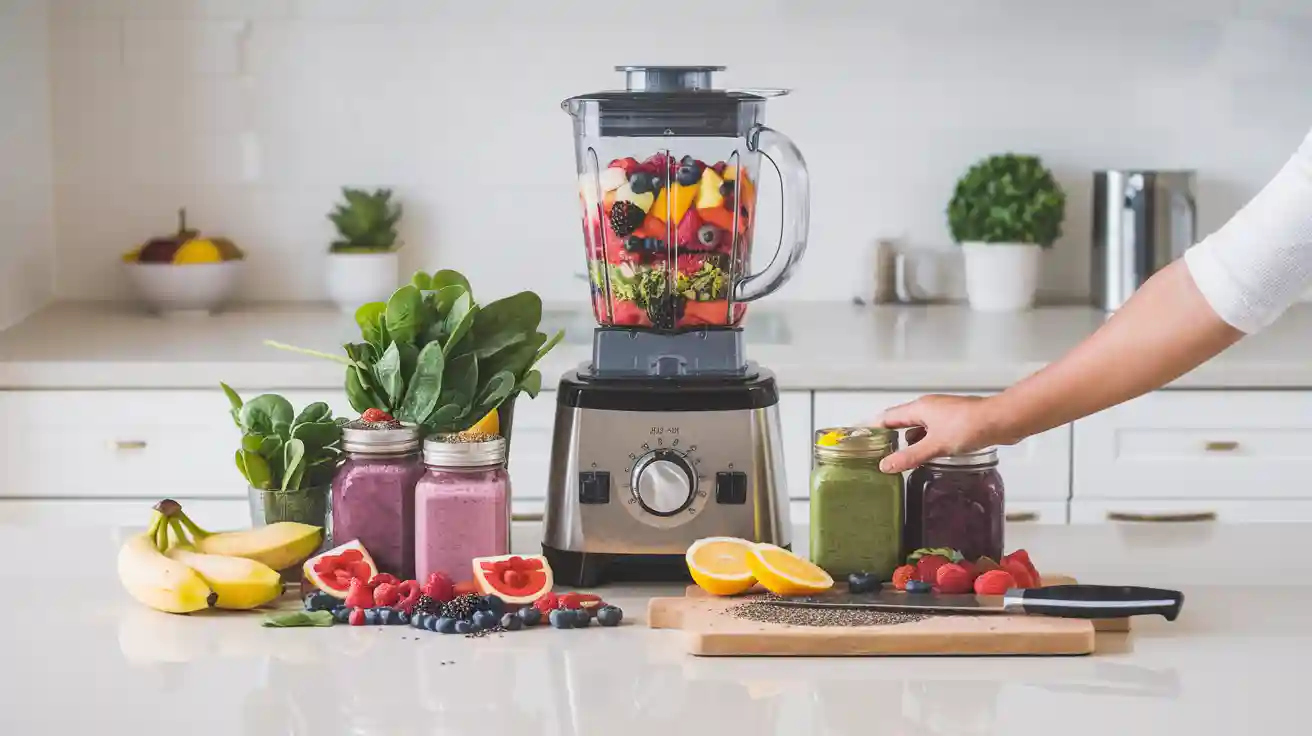
You deserve a daily smoothie that tastes amazing and feels like a treat. Blenders for smoothies help you reach that smooth, creamy drink every time. Check out how the smoothie trend keeps growing:
| Metric | Value | Year/Period |
|---|---|---|
| Global Smoothies Market Size | USD 12.46B | 2023 |
| Projected Market Size | USD 23.08B | 2030 |
When you use the right blender, you get better creaminess and a creamy texture. Blenders for smoothies can boost nutrition by keeping more healthy parts of the fruit in your creamy smoothie. You get fast prep, great taste, and perfect smoothie consistency with every blender session.
Choosing Blenders for Smoothies
Key Features for Smoothie Consistency
You want your smoothie to be creamy, not chunky. The right blender makes all the difference. When you look for blenders for smoothies, focus on features that help you get the best smoothie consistency every time. Here are some things to check:
- Strong motor power helps you blend frozen fruit, leafy greens, and nuts with ease.
- Sharp, durable blades crush ice and tough ingredients for a smooth texture.
- Large, BPA-free containers let you make more smoothie at once and keep things safe.
- Multiple speed settings and pre-programmed cycles give you control over how you blend.
- Noise reduction features make your morning routine quieter.
- Easy-to-clean parts save you time after you blend.
| Feature | Why It Matters for Smoothies |
|---|---|
| Motor Power | Blends tough ingredients for smooth results |
| Blade Design | Ensures even blending and creamy texture |
| Container Size | Lets you make single or family-size smoothies |
| Control Settings | Helps you adjust for perfect consistency |
| Noise Reduction | Keeps blending quiet and stress-free |
Tip: If you love thick smoothie bowls or add-ins like seeds, look for the best blenders for smoothies with strong motors and special blades.
Types of Blenders for Smoothie Lovers
You have lots of choices when it comes to smoothie makers. Each type fits a different lifestyle. Here are the main types:
- Countertop blenders: These are powerful and handle big batches. They work well for families or anyone who likes to prep ahead.
- Personal blenders: These are compact and perfect for single servings. You can blend and go, which is great for busy mornings.
- High-speed blenders: These blend tough ingredients fast. They give you the smoothest texture and can even make nut butter or soups.
- Immersion blenders: These are handy for quick blends right in your cup or bowl. They work best for softer ingredients.
Blenders for smoothies now come with features like smoothie-specific settings, personal cups, and even app controls. Many people want blenders that can handle plant-based ingredients, seeds, and ice. The best blenders also use safe, durable materials and offer easy cleaning. If you want a budget-friendly option, personal blenders work well. For more power and features, high-end models give you more control and better smoothie consistency.
How to Make a Smoothie: Prep and Layering

Prepping Ingredients for the Perfect Smoothie
You want to know how to make a smoothie that tastes great every time. It all starts with prepping your ingredients the right way. When you prepare your smoothie ingredients ahead of time, you save minutes in the morning and make sure your smoothie turns out just right.
Start by picking a mix of protein, fruits, veggies, healthy fats, and a liquid base. Registered dietitians suggest building your smoothie like a balanced meal. You can use Greek yogurt, nut butters, or soy protein isolate for protein. Add leafy greens like spinach or kale for a green smoothie. Toss in fresh fruit or frozen fruit for sweetness and texture. Don’t forget a splash of almond milk, coconut water, or even plain water as your liquid.
Tip: Measure your ingredients before you blend. This helps you get the perfect smoothie every time and keeps your nutrition on track.
If you want to make mornings easier, try prepping your smoothie ingredients in advance. Place your fruits, nuts, and add-ins into small bags or containers. Store them in the fridge or freezer. When you’re ready, just grab a bag, add your liquid, and blend. This method works well for busy families and makes it easy to try new smoothie ideas for kids or adults.
Studies show that adding the right amount of soy protein isolate and pectin can make your smoothie thicker and smoother. These ingredients help your smoothie feel creamy and prevent it from getting gritty. But don’t add too much protein powder or sweetener, or you might notice a strange taste. If you want to boost nutrition, try using high hydrostatic pressure (HPP) treatment. This process keeps your smoothie safe, increases vitamin C, and makes your smoothie more colorful and fresh.
A clinical study found that the way you choose and combine your ingredients can change how your body reacts to your smoothie. For example, using the right mix of carbs and protein can help control blood sugar and keep you full longer. So, when you look for smoothie recipe ideas, think about what you want from your smoothie—energy, protein, or just a tasty treat.
Here’s a quick checklist for prepping your smoothie ingredients:
- Wash and chop fruits and veggies into small pieces.
- Measure out protein, fats, and liquids.
- Portion everything into bags or containers for easy grab-and-go.
- Store non-frozen items in the fridge and frozen items in the freezer.
- Try new combinations for fun smoothie ideas.
If you want to make fruit smoothies or green smoothies, always use the freshest ingredients you can find. This gives you the best flavor and nutrition. You can even prep a few top-rated smoothie recipes at once and freeze them for later.
The Best Order to Layer Ingredients
Now that you have your ingredients ready, let’s talk about how to make a smoothie with the best texture. The order you add your ingredients to the blender matters. It helps your blender work better and gives you a smoother drink.
Here’s the best way to layer your smoothie ingredients:
- Start with liquids. Pour almond milk, coconut water, or juice into the blender first. This helps the blades move and pulls everything down.
- Add powders and sweeteners next. Things like protein powder or honey dissolve better when they hit the liquid first.
- Toss in leafy greens. Spinach or kale blends smoother when it sits closer to the blades.
- Add soft ingredients like yogurt or nut butter. These make your smoothie creamy.
- Drop in fresh fruit, nuts, and seeds. Cut fruit into chunks for easier blending.
- Finish with frozen fruit and ice. The weight of these ingredients pushes everything down for even blending.
Note: If you want to avoid chunks or powdery bits, always follow this order. It helps your blender create a strong vortex, mixing everything evenly.
Some smoothie recipes suggest pre-blending your greens with the liquid for an extra smooth green smoothie. You can also cut large pieces of fruit into smaller chunks. This helps your blender work faster and gives you a perfect smoothie every time.
If you want to try top-rated smoothie recipes, follow this layering method. It works for all kinds of smoothie ideas, from classic fruit smoothies to creative smoothie ideas for kids. You can even use this order for new smoothie recipe ideas you invent yourself.
When you know how to make a smoothie with the right prep and layering, you get a drink that’s smooth, tasty, and packed with nutrition. Try prepping your ingredients and layering them like a pro. You’ll see how easy it is to upgrade your daily smoothie routine.
How to Blend a Smoothie Like a Pro
Blending Settings and Techniques
You want to know how to blend a smoothie that feels creamy and tastes amazing. The right settings and techniques make all the difference. Start by adding your ingredients in the right order. Always pour liquids first, then add powders, soft items, fruits, and finally ice or frozen ingredients. This helps your blender work smoothly and protects the blades.
When you turn on your blender, begin at a low speed. Let the ingredients fall into the blades. Slowly increase the speed to medium and then high. This step-by-step approach gives you a creamy texture and prevents big chunks from sticking around. If your blender has a pulse setting, use it for tough ingredients like frozen fruit or nuts. Pulse blending breaks down hard pieces without over-mixing, which keeps your smoothie thick and creamy.
Here’s a quick list to help you remember how to blend a smoothie like a pro:
- Use fresh, hard ice for the best texture without watering down your drink.
- Layer ingredients from liquids to solids, with ice on top.
- Start blending at low speed, then move up to high.
- Use pulse blending for tough ingredients.
- Match the speed and setting to your smoothie recipes.
- Never overfill the blender jar—keep it less than half full for thick blends.
- Always secure the lid before you start.
| Feature | Description | Benefit for Professional Smoothie Crafting |
|---|---|---|
| Powerful Commercial-Grade Motor | Blends tough ingredients fast and smooth | Reduces wait times, ensures creaminess, improves satisfaction |
| Variable Speed Control | Lets you adjust speed for each recipe | Optimizes texture and consistency for different blends |
| Durable Stainless Steel Blades | Stays sharp and strong for heavy use | Keeps blending performance high and reduces repairs |
| Thermal Protection System | Stops the motor from overheating | Makes your blender last longer and reduces downtime |
| User-Friendly Interface | Easy controls for anyone to use | Makes blending quick and consistent |
Some blenders come with preset smoothie programs. These settings take the guesswork out of blending. Just press the button, and the blender does the rest. If you want to try new smoothie recipes, use the variable speed controls to fine-tune your blend. For a satisfying blend every time, follow these steps and use the right settings.
Boosting Nutrition and Flavor
You want your smoothie to taste great and give your body the nutrients it needs. The way you blend your ingredients can help you keep more vitamins, minerals, and fiber in your drink. Research shows that blending keeps most nutrients intact, especially if you control the speed and avoid too much heat. Water-soluble vitamins like vitamin C stay stable if you don’t over-blend or let the mixture get hot.
Blending at lower speeds and using the pulse function helps protect delicate nutrients and enzymes. This means your smoothie stays fresh and healthy. If you want to boost the health benefits, add ingredients like leafy greens, berries, seeds, or protein powder. These add-ins give you more fiber, antioxidants, and healthy fats.
You can also use new technologies like high-pressure processing (HPP) or pulsed electric fields. These methods help keep more vitamins and antioxidants in your smoothie. For example, HPP keeps vitamin C and color bright in fruit smoothies. Ultrasound blending can increase the amount of healthy polyphenols and improve flavor. If you want healthier smoothies, try adding boosters like pectin, protein, or even calcium. These not only improve nutrition but also make your smoothie thicker and creamier.
| Additive/Booster or Technology | Food Matrix | Nutritional Impact | Flavor/Structural Impact |
|---|---|---|---|
| HPP (High Pressure Processing) | Soy and milk smoothies | Keeps minerals stable | Changes texture and viscosity |
| Ultrasounds | Fruit juices | Keeps vitamin C and antioxidants | Improves flavor and color |
| Functional food ingredients | Various foods | Adds health benefits, longer shelf-life | Enhances flavor and texture |
When you know how to blend a smoothie with the right techniques and boosters, you get a drink that is both tasty and packed with nutrients.
Troubleshooting Common Smoothie Issues
Sometimes, even when you follow all the steps, your smoothie doesn’t turn out right. Maybe it’s too thin, too thick, or has weird chunks. Don’t worry! You can fix most problems with a few simple tricks.
If your smoothie is too thin, add more frozen fruit, ice, or a spoonful of nut butter. This thickens the blend and gives you more creaminess. If it’s too thick, pour in a little more liquid and blend again. For chunks or powdery bits, check your layering order and blend longer at a higher speed.
Blenders sometimes create very small particles, called debris, that make your smoothie gritty. Studies show that changing your blending time and speed can help control the size of these particles. If you notice your smoothie feels gritty, try blending in short bursts and use the pulse setting.
Common blender problems include motor burnout, dull blades, and mechanical wear. These issues can make it hard to get a creamy texture. To avoid them, don’t overload your blender and always use sharp blades. Clean your blender after each use to keep it working well.
Here’s a quick troubleshooting guide:
| Problem | Solution |
|---|---|
| Too thin | Add frozen fruit, ice, or nut butter |
| Too thick | Add more liquid and blend again |
| Chunks or powdery bits | Check layering, blend longer, use pulse |
| Gritty texture | Blend in short bursts, adjust speed |
| Motor or blade issues | Don’t overload, keep blades sharp, clean often |
Tip: If you want a smoother blend, always start slow and increase speed. Use the pulse setting for tough ingredients and never fill the jar past the max line.
Learning how to blend a smoothie with these tips helps you get the most out of your ingredients. You’ll enjoy a creamy, healthy drink every time. Try new smoothie recipes and experiment with different ingredients to find your perfect blend.
You can upgrade your daily smoothie routine with just a few easy changes. Try new ingredients and blending techniques to find your favorite texture. Many users love how advanced blenders save time, boost nutrition, and make cleanup simple.
- Top models deliver smooth results with less effort
- Self-cleaning programs add convenience
- Durable designs last for years
FAQ
What is the best way to clean my blender after making a smoothie?
Add warm water and a drop of dish soap. Blend for 30 seconds. Rinse well. This quick trick keeps your blender fresh and ready.
Can I use frozen fruit in any blender?
Yes, you can use frozen fruit. For best results, pick a blender with a strong motor and sharp blades. This helps you get a smooth blend.
How do I make my smoothie thicker?
Try adding more frozen fruit, Greek yogurt, or a spoonful of nut butter. These ingredients give your smoothie a rich, creamy texture.


